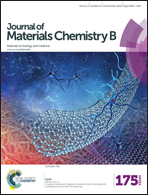Advances in collagen, chitosan and silica biomaterials for oral tissue regeneration: from basics to clinical trials
Abstract
Different materials have distinct surface and bulk characteristics; each of them potentially useful for the treatment of a particular wound or disease. By reviewing those materials that have reached a clinical stage the reader will have a broad panorama of the possibilities a particular material can offer, regarding its ability to support fast tissue regeneration. This review covers the most recent advances made towards the development of biomaterials aimed to support regenerative processes. Indeed, we highlight key examples, from basic research to clinical trials, of biomaterials for a specific biomedical application. In this context, the focus is made on collagen, chitosan and silica which are key representatives of a protein, a polysaccharide and an inorganic material usually employed as biomaterials. Particularly, this review article presents an overview of their potential therapeutics in the treatment of disorders within the oral mucosa and tooth supporting tissues. Finally, the importance of in vivo and in vitro studies, clinical evidence studies, systematic reviews and meta-analyses as an adequate guidance for biomaterial design and development is highlighted.


 Please wait while we load your content...
Please wait while we load your content...